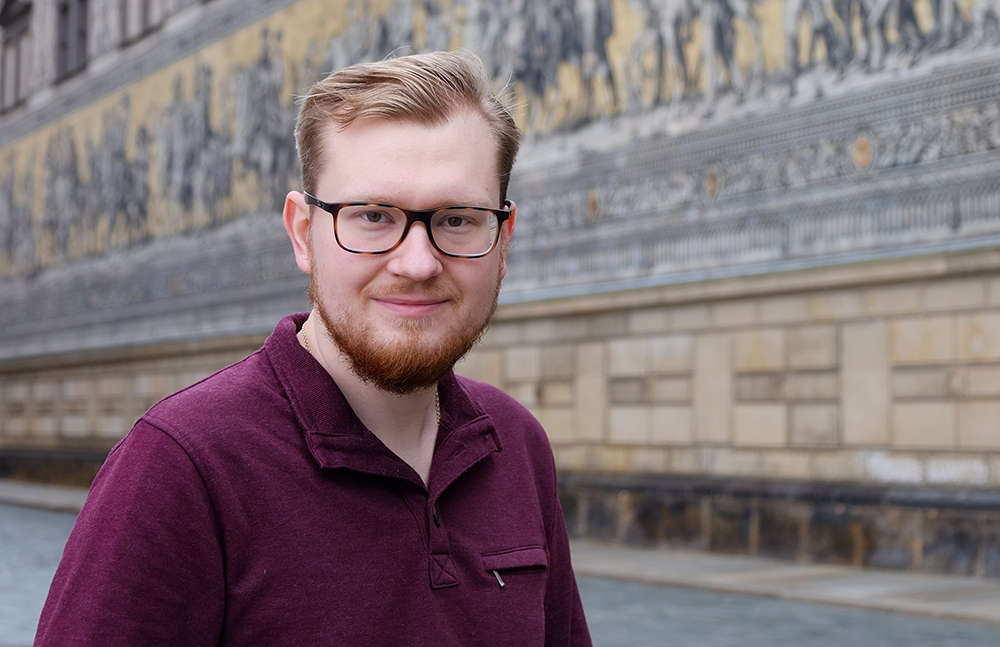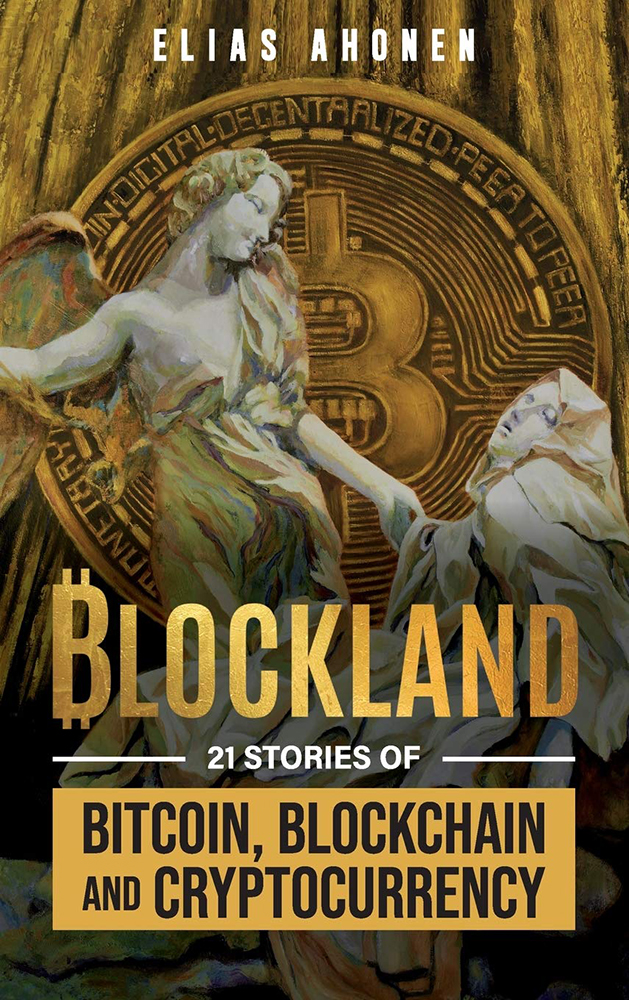Elias Ahonen (BA ’17) wrote, edited and self-published his book Blockland: 21 Stories of Bitcoin, Blockchain and Cryptocurrency while living alone for a year in his ancestral homestead in Finland, hunting his own food and cooking it in a wood-fired sauna.
“A lot of authors work within a structure and established system,” says the cryptocurrency consultant and educator. “But with blockchain and cryptocurrency, there isn't an established system, there is no precedent for it. It’s a brand-new universe. It’s the same with my book.”

Elias Ahonen is author of the book Blockland: 21 Stories of Bitcoin, Blockchain and Cryptocurrency.
Ahonen, who is also a student of law at the University of Turku in Finland, realized there was a need for an academic historical overview of the paradigm-shifting 13-year cryptocurrency movement – and that he was uniquely positioned to write it. He felt writing of the book needed to be completed outside of established structures and systems, in a mindset free from attachment to the everyday world.
Writing outside of his comfort zone is probably easier for Ahonen than most people, because his life is far from ordinary.
Ahonen immigrated to Canada from Finland in 2001, the same year his mother, Heidi Ahonen, started at as a professor of music therapy at Laurier. She currently serves as the director of Laurier’s Manfred and Penny Conrad Institute for Music Therapy Research.

The cover of Elias Ahonen's Blockland: 21 Stories of Bitcoin, Blockchain and Cryptocurrency.
Ahonen began studies Laurier in 2012, majoring in political science. He admits his background in political science surprises people, who assume that his deep dive into the world of cryptocurrency must have launched from a more technology or business-focused degree.
“I picked arts because I felt it gave a broader idea of the world, a broader idea of society and how it functions,” he says.
Ahonen was intrigued by what he learned at university about how governments regulate individuals, organizations and transactions through socially defined currency structures. Outside of the classroom, he was getting into Bitcoin, having purchased $20 worth in 2013 through the online game Second Life.
“With Bitcoin, I noticed that these powers became effectively nullified,” he says. “If I have Canadian dollars in my bank account, the government can use its authority to confiscate it, or control me through it. With a digital currency like Bitcoin, it’s only accessible through a password I have in my head. No one can take that. That’s fundamentally disruptive.
“From the perspective of traditional political science, this goes against all the rules, this shouldn’t be possible. It’s a revolution.”
Bitcoin. Cryptocurrency. Blockchain. What are they and how do they relate to each other?
Let's start with blockchain. Ahonen notes that blockchain isn’t a currency – it's a system for tracking transactions that can be applied to any currency or system of exchange.
When a product or service is exchanged on the blockchain, a digital record is created recording that transaction, like a receipt. Except while a receipt can be separated from a product or service, on the blockchain that receipt remains digitally connected and it can’t be altered. In simple terms, it is as if every dollar bill had the name of every user and the dates the bill was used on it in indelible ink.
The result is a very transparent system that can’t be controlled or falsified by any individual or group. Instead, Ahonen says, blockchain operates like the laws of science: by its own internal rules of functioning, rather than by policy or pressure.
A cryptocurrency is an exchange system that generates wealth – called “coins” – based on the solving of mathematical puzzles by computing power, which are then recorded on the blockchain. Bitcoin was the first, though many other cryptocurrencies have since been developed. Users can “mine,” or create, Bitcoin by competing with each other to solve these puzzles, or they can buy and sell it on cryptocurrency exchanges, including for government-issued currency.
“By the time I graduated from Laurier, I had learned how to be an academic,” says Ahonen. “To use dispassionate observation, to have the ability to impartially analyze and write about something.”
It was a skill he used in writing Blockland, which provides exceptional detail gleaned from Ahonen’s own experience, which includes wild adventures as part of his travels around the world. When not writing or studying, Ahonen works to help international companies engage with cryptocurrency, create startups and attends conferences.
– Elias Ahonen
The book certainly isn’t dry: Ahonen has a flair for the creative, using metaphors and engaging storytelling to bring the technical topic to life. Throughout the book, he rigorously maintains a commitment to observation and reflection, not opinion. He says this is especially important in a cryptocurrency community that is rife with infighting, black market activity and not well understood by the average individual.
“I wanted the book to serve as a unifying text for the cryptocurrency industry as a whole,” says Ahonen. “It’s a very tribalistic industry, people have serious fights within it, deep ideological disagreements. So you can’t always trust what people are saying.”
Ahonen hopes his long-term involvement in the community – he is also the author of the 2016 book Encyclopedia of Physical Bitcoins and Crypto-Currencies – balanced with his reflective approach will allow people to see Blockland as an accurate collective history that reflects a range of perspectives.
As a writer, Ahonen also considers himself a connector between a highly technical world and the mainstream – a skill he credits in part to his education at Laurier, as well as a balanced right-brained and left-brained personality. He hopes Blockland will provide a solid base for future academics researching what he considers to be a pivotal time in history.
(resources recommended by Elias Ahonen):
Best mobile app: Crypto.com
Market prices, charts and rankings: Coingecko.com
News: Cointelegraph.com
Industry job board: Crypto.jobs
Exchange: Kraken.com
“It’s incredibly exciting and a lot of very positive developments can come out of this,” says Ahonen. “But, at the same time, when you have a revolution there is a lot of pain and suffering, too. I’m concerned what this transition will look like. Is it something that will make things better in a utopian way, or will it bring significant complications to the global community?
“It can’t be ignored and I’m on board to help people learn about it. I try not to make an argument about whether it’s a universal ‘good’ or ‘bad.’ It just is, that’s the main thing.”
The impacts are real. Cryptocurrency mining has a significant impact on the environment (according to the University of Cambridge, Bitcoin is now consuming more energy than the country of Argentina), it can facilitate organized crime (you can use cryptocurrency on the “dark web” for illegal activities), and it has the potential to disrupt already fragile global economies – and individual investment plans – all without any centralizing method of control.
“Big risk, huge returns,” says Ahonen. “Some people are drawn to that and some people wouldn’t step their foot into that.”
While Ahonen considers the rise of cryptocurrencies to be a revolution, he also sees a potentially more commonplace future for at least one part of the movement. He believes that while the average person is unlikely to become a Bitcoin user (although cryptocurrency ATMs are popping up across southern Ontario, including near Laurier’s campuses), blockchain technology will be integrated into mainstream institutions, providing a more secure and transparent way of organizing data.
“At this point, it’s not something you can dismiss as a fad,” says Ahonen. “It is increasingly complex and touches everything. Being in the middle of this, observing and recording and trying to explain it, trying to understand it, is utterly fascinating. I can’t think of anything I’d rather do.”